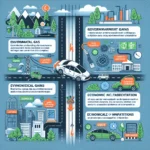Climate change and its associated disasters have become increasingly pressing issues in recent years. As a result, the role of technology in mitigating and preventing these climate-induced catastrophes has emerged as a popular topic in IELTS Writing Task 2 essays. This article will provide sample essays at different band levels, along with detailed analyses to help you understand how to approach this subject effectively in your IELTS exam.
Analyzing the Topic
The role of technology in preventing climate-induced disasters is a multifaceted subject that combines elements of environmental science, technological innovation, and disaster management. This topic has appeared in various forms in past IELTS exams and is likely to continue being relevant due to the ongoing global climate crisis.
For our sample essays, we will focus on the following question:
Some people believe that technology can solve the problem of climate-induced disasters, while others think that human behavior change is more important. Discuss both views and give your own opinion.
This question requires candidates to explore both perspectives on addressing climate-induced disasters and express their own stance on the matter.
Sample Essay 1 (Band 8-9)
Climate change has led to an increase in natural disasters worldwide, prompting debates about the most effective ways to mitigate these catastrophes. While some argue that technological advancements hold the key to solving this issue, others contend that altering human behavior is more crucial. In my opinion, a combination of both approaches is necessary to tackle this complex problem effectively.
Proponents of technology-based solutions argue that innovative tools and systems can significantly reduce the impact of climate-induced disasters. For instance, advanced early warning systems using satellite imagery and artificial intelligence can predict extreme weather events with greater accuracy, allowing for timely evacuations and preparedness measures. Moreover, green technologies such as renewable energy sources and carbon capture systems can help mitigate the root causes of climate change, thereby reducing the frequency and intensity of related disasters in the long term.
On the other hand, those who prioritize behavioral change emphasize the importance of individual and collective actions in combating climate-induced calamities. They argue that without a fundamental shift in human attitudes towards consumption, energy use, and environmental conservation, technological solutions alone will be insufficient. Advocates of this view point to the success of initiatives like community-based disaster preparedness programs and sustainable lifestyle movements in reducing vulnerability to climate-related hazards.
In my view, the most effective approach to preventing climate-induced disasters lies in harnessing both technological advancements and behavioral modifications. While technology can provide powerful tools and innovative solutions, their implementation and success ultimately depend on human acceptance and adaptation. For example, the development of flood-resistant infrastructure is only effective if coupled with proper urban planning and community engagement in flood-prone areas.
flood-resistant-infrastructure|flood resistant infrastructure|A modern city built with flood-resistant infrastructure, incorporating green spaces and elevated structures.
In conclusion, addressing the challenge of climate-induced disasters requires a holistic approach that leverages technological innovations while promoting positive changes in human behavior. By combining these strategies, we can create more resilient communities and mitigate the devastating effects of climate change on a global scale.
(Word count: 309)
Analysis of Band 8-9 Essay
This essay demonstrates excellent qualities that align with Band 8-9 criteria:
-
Task Response: The essay fully addresses all parts of the task, discussing both views and clearly presenting the writer’s opinion.
-
Coherence and Cohesion: The ideas are logically organized with clear progression throughout the essay. Paragraphs are well-linked, and cohesive devices are used effectively.
-
Lexical Resource: The vocabulary is sophisticated and precise, with a wide range of words used appropriately (e.g., “mitigate,” “innovative,” “vulnerability”).
-
Grammatical Range and Accuracy: The essay showcases a wide range of complex structures used accurately and flexibly.
-
Examples: Specific and relevant examples are provided to support the arguments (e.g., early warning systems, community-based disaster preparedness programs).
-
Balanced Argument: Both perspectives are discussed equally before the writer presents their own nuanced opinion.
-
Conclusion: The conclusion effectively summarizes the main points and reinforces the writer’s stance.
Sample Essay 2 (Band 6-7)
These days, climate change is causing more natural disasters around the world. Some people think technology can fix this problem, while others believe changing human behavior is more important. I will discuss both views and give my opinion.
On one hand, technology can help prevent climate-induced disasters in many ways. For example, scientists can use computers to predict weather better, which can warn people about storms or floods early. Also, new inventions like solar panels and electric cars can reduce pollution, which is a main cause of climate change. If we use less fossil fuels, we might have fewer disasters in the future.
On the other hand, changing how people act is also very important. Many experts say that if we don’t change our habits, like using too much energy or throwing away too much trash, technology alone can’t solve the problem. People need to learn about climate change and do things to help, like recycling or using public transport. This can make a big difference in reducing the effects of climate change.
In my opinion, we need both technology and behavior change to prevent climate disasters. Technology can give us tools to fight climate change, but people need to use these tools properly. For instance, even if we have good flood barriers, people still need to follow evacuation plans when there’s danger.
To sum up, I believe that using new technologies and changing how we live are both necessary to stop climate-induced disasters. We should focus on developing new technologies while also educating people about how to live in a more environmentally friendly way.
(Word count: 270)
Analysis of Band 6-7 Essay
This essay demonstrates qualities that align with Band 6-7 criteria:
-
Task Response: The essay addresses all parts of the task, discussing both views and presenting the writer’s opinion. However, the ideas could be developed more fully.
-
Coherence and Cohesion: The essay is generally well-organized, but some transitions between ideas could be smoother.
-
Lexical Resource: The vocabulary is adequate for the task, with some attempts at more sophisticated words (e.g., “climate-induced,” “evacuation”). However, there is some repetition and less precision compared to the Band 8-9 essay.
-
Grammatical Range and Accuracy: The essay uses a mix of simple and complex sentences, with generally good control of grammar. There are some minor errors, but they do not impede communication.
-
Examples: The essay provides examples to support arguments, but they are less specific and developed compared to the higher band essay.
-
Balanced Argument: Both perspectives are discussed, but the treatment is less nuanced than in the Band 8-9 essay.
-
Conclusion: The conclusion summarizes the main points and restates the writer’s opinion, but it could be more impactful.
Key Vocabulary for Climate and Technology Essays
-
Mitigate (verb) /ˈmɪtɪɡeɪt/ – to make something less harmful, serious, or bad
-
Resilient (adjective) /rɪˈzɪliənt/ – able to recover quickly from difficult conditions
-
Sustainable (adjective) /səˈsteɪnəbl/ – able to continue over a period of time without damaging the environment
-
Innovative (adjective) /ˈɪnəveɪtɪv/ – introducing or using new ideas, ways of doing something, etc.
-
Infrastructure (noun) /ˈɪnfrəstrʌktʃə(r)/ – the basic systems and services that a country or organization uses in order to work effectively
-
Vulnerability (noun) /ˌvʌlnərəˈbɪləti/ – the quality or state of being exposed to the possibility of being attacked or harmed, either physically or emotionally
-
Artificial Intelligence (noun) /ˌɑːtɪfɪʃl ɪnˈtelɪdʒəns/ – the study of how to produce machines that have some of the qualities that the human mind has, such as the ability to understand language, recognize pictures, solve problems, and learn
-
Carbon capture (noun) /ˈkɑːbən ˈkæptʃə(r)/ – the process of trapping carbon dioxide produced by burning fossil fuels or other chemical or biological processes and storing it in such a way that it is unable to affect the atmosphere
-
Early warning system (noun) /ˈɜːli ˈwɔːnɪŋ ˈsɪstəm/ – a system designed to detect and warn of impending danger or risk
-
Renewable energy (noun) /rɪˈnjuːəbl ˈenədʒi/ – energy from a source that is not depleted when used, such as wind or solar power
Conclusion
The role of technology in preventing climate-induced disasters is a complex and relevant topic for IELTS Writing Task 2 essays. By understanding the key elements of a strong essay and practicing with sample questions, you can improve your ability to tackle this subject effectively in your exam.
Some potential future essay questions on this topic might include:
- To what extent can technological advancements alone solve the problem of climate change?
- Discuss the pros and cons of relying on technology to combat climate-induced disasters.
- Some people argue that investing in technology to prevent climate disasters is more important than funding disaster relief efforts. To what extent do you agree or disagree?
Remember to practice writing essays on these topics, focusing on clear organization, relevant examples, and a well-developed argument. Feel free to share your practice essays in the comments section below for feedback and discussion with other learners. Good luck with your IELTS preparation!


